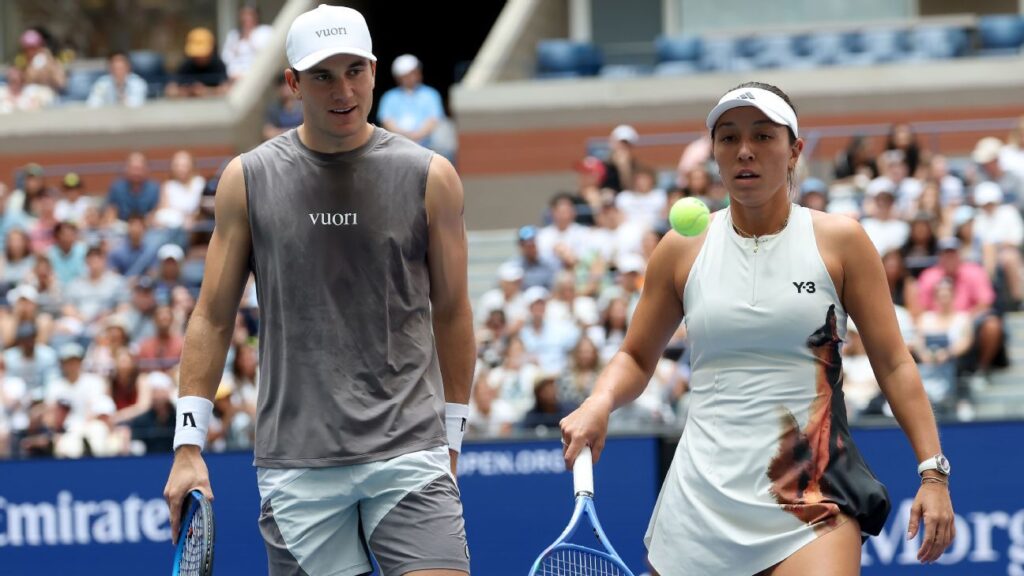NEW YORK — The revamped US Open mixed doubles tournament — which drew plenty of criticism for everything from its format (shorter matches) to its field (only 16 teams) — got underway Tuesday and is already down to its final four, with the trophy and $1 million prize at stake Wednesday night.
Casper Ruud and Iga Swiatek, the No. 3 seeds, easily won their two matches and will face the top-seeded duo of Jessica Pegula and Jack Draper in one semifinal Wednesday. Defending champions Sara Errani and Andrea Vavassori, the only traditional mixed doubles team in the fast-pace event, meet Danielle Collins and Christian Harrison — who weren’t even the draw until Jannik Sinner and Katerina Siniakova withdrew Tuesday morning because of Sinner’s illness — in the other.
“This is the official mixed doubles. If we get to the final tomorrow, I’m sure everyone is going to be pretty determined to try to win this thing,” Ruud said.
With mostly singles players, some who rarely play doubles at all, and an unusual scoring system, it felt so much like an exhibition that Pegula had to scold partner Draper when he called it just that in their news conference.
“He shouldn’t be saying that, but that’s OK,” Pegula said, later adding that “it’s not an exhibition.”
Past US Open singles champions Carlos Alcaraz and Emma Raducanu were quickly eliminated with a 4-2, 4-2 loss to Pegula and Draper. The No. 2 seeds, Taylor Fritz and Elena Rybakina, also went quickly in a 4-2, 4-2 loss to Errani and Vavassori. Novak Djokovic and teammate Olga Danilovic also were one-and-done.
Those types of Grand Slam singles champions are exactly the types of players the U.S. Tennis Association was seeking when it revamped the tournament and cut it in down from 32 teams.
Now played over two days, mixed doubles starts well before the singles tournaments begin on Sunday, with organizers believing singles stars would be more interested in playing if it didn’t interfere with their rest and recovery during that event.
Traditional doubles specialists like Errani and Vavassori were among the biggest critics of the changes. The prize of $1 million to the winning team would be a huge boost to doubles players, but most of them never had a chance of competing for it this year. Errani and Vavassori said they were playing for those teams, but also acknowledged the potential benefit of the new event.
“I have to say that as everything, there are always positives and negatives. But the positives are for sure that the stadium was packed in the second match,” Vavassori said. “It’s a great thing for doubles to be seen by more people. I have to give them credit. I also said it before, playing this format is great for doubles and mixed doubles to develop in the future.”
Errani and Vavassori didn’t even know originally if they would get a chance to defend their title in the new format, which gives eight teams automatic spots based on the players’ combined singles rankings. The other spots are wild cards awarded by the USTA.
When Errani and Vavassori won the title last year in Flushing Meadows, it was late in the second week of the tournament in a stadium with plenty of empty seats.
The new schedule has mixed doubles being played now when usually the only competitions taking place are the qualifying events for the singles tournaments. Admission onto the grounds during what the USTA calls “fan week” is free, so Louis Armstrong Stadium stadium was packed for the opening match, a far bigger crowd than mixed doubles generally draws.
Some fans may not have even realized that the match was headed to a second set after Errani and Vavassori took the opener in just 19 minutes. In traditional tennis scoring, they would have had to win six games instead of four to win the set.
The sets to four games with a 10-point match tiebreaker instead of a third set were to be used through the semifinals. Only the final would resemble a regular match, with sets to six games, tiebreakers at 6-all and a 10-point tiebreak for a third set.
The Associated Press contributed to this report.


